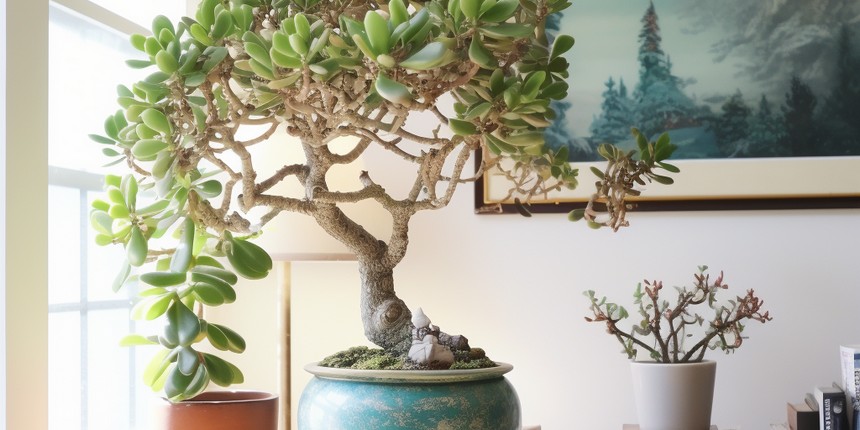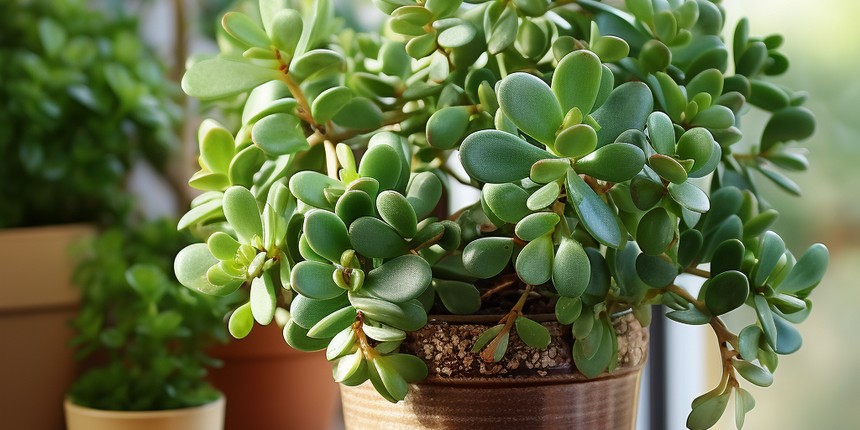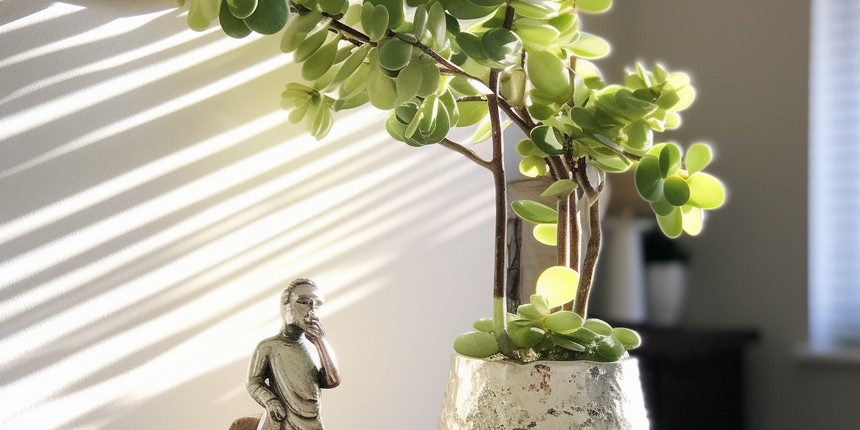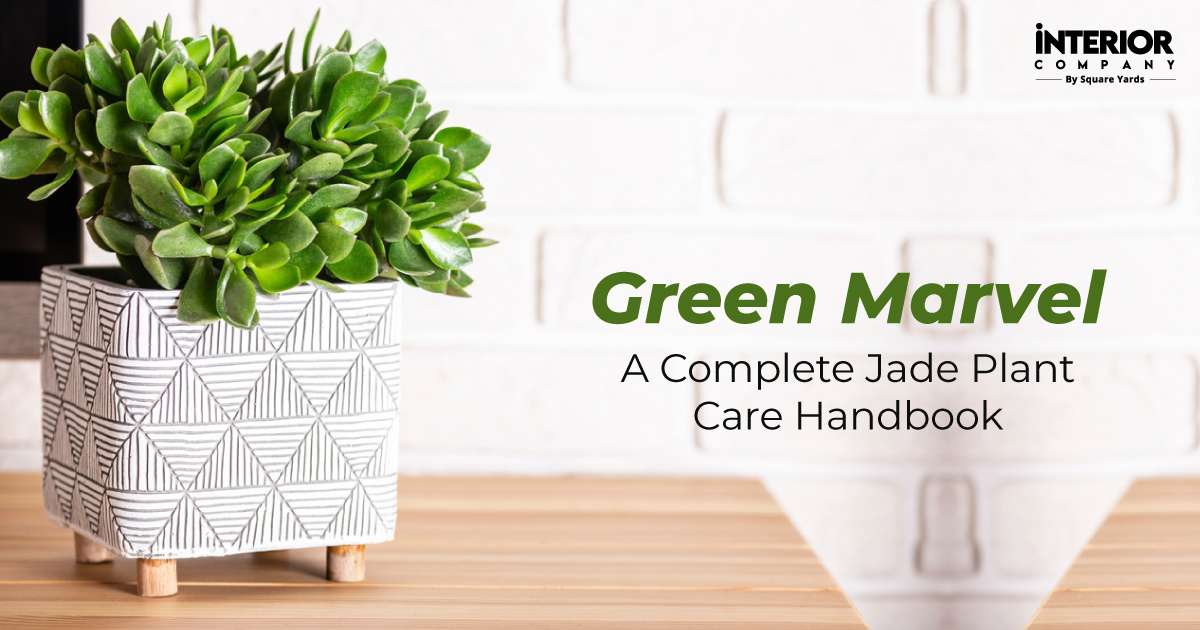These ultra-low maintenance plants are completely adorable. With thick, lustrous green leaves and woody stems, Jade plants seem like miniature trees. These plants have a long life span and can live up to 70-100 years with proper jade plant care. Native to South Africa, jade plants are easy to grow and have been a favourite among gardeners and plant enthusiasts for decades. Even though the plant is slow-growing—roughly two inches a year—jade plants in height can reach up to three to six feet.
In addition, these succulents don’t mind being root-bound, so you can easily repot them after three to four years. Owing to their availability in a variety of types, they make an attractive addition to your home. No matter which you choose, in this comprehensive guide, we will explore everything you need to know about growing, planting, and expertly caring for crassula jade plants.
Jade Plant Overview
| Common Name | Jade plant |
| Genus Name | Crassula |
| Plant Type | Succulent |
| Family | Crassulaceae |
| Soil Type | Well-drained |
| Colour of Flower | Pink/ White |
| Bloom Time | Spring |
| Height | 3 -10 ft |
| Width | 2–3 ft |
| Features | Low Maintenance and Good for Containers |
| Zones | 11 |
| Toxic | Dogs and Cats |
Ideal Conditions for Growing Jade Plant

To grow a thriving jade plant, a replica of its native South African habitat, provide four to six hours of indirect sun per day. When growing jade indoors, ensure well-draining soil and a room temperature between 60-75°F (18-24°C). While jade plants are drought-tolerant, fertilise with a balanced, water-soluble solution every 6-8 weeks during the growing season. Alternatively, specialised potting mixes designed for succulents and cacti can also be used. In the outdoors jade plants tend to be slow growers, require dry, warm weather and plenty of room to grow as they can stretch to 10 feet in height under favourable conditions.
Jade Plant Care Tips
Caring for a jade plant is easy, make sure to provide a hot, sunny environment and the basic needs of soil, water, and light. Place the jade aka crassula ovata plant in an east, south, or west-facing window.
Here are the key factors required for growing a jade plant:
Light
Jade plants are sun-loving succulents, they need four to six hours of indirect sunlight a day. However, too much direct sunlight can be harsh and damage the leaves. To provide the ideal light conditions for your jade plant, place it near a window with filtered sunlight. If you notice the leaves becoming reddish or brown, it’s a sign that the plant is receiving too much light and should be moved to a slightly shadier spot. Conversely, in low-light conditions, the jade houseplant will have gawky growth, resulting in a weak plant- instead of a bushy appearance.

Bring life into your kitchen or living room decor with the addition of a Jade plant. Place it around the windows for maximum utilisation and brightness.
Soil
Well-draining gritty soil is crucial for jade plants, as they are susceptible to root rot if their roots are consistently moist. A cactus or succulent mix is an excellent choice for planting your jade. When repotting your jade plant, it’s best to use a potting mix for soil for succulents that have drainage holes to prevent water from accumulating in the bottom of the container. Another method to prevent moisture retention is to choose terracotta or clay pots, as they are porous and can readily absorb water from the soil.
Water
Jade plants are drought-tolerant, and overwatering is a common mistake that can harm them. Apply the principle Less is More, when watering the jade plant. Although during the spring and summer months, jade plants grow actively and may need a little more water. Watering only once a week or even once a month to keep the soil slightly moist should suffice. You can check the moisture level by inserting your finger into the soil. Water the plant thoroughly, allowing excess water to drain from the pot. In addition, you can check the leaves like shrivelled leaves to indicate that the plant is lacking in water, while puffy ones suggest that the plant is overwatered. Always use filtered water, since tap water can contain salts and minerals that might be harmful to jade plant maintenance.
Temperature

Jade plants prefer mild household temperatures. They can tolerate a range of temperatures but thrive in an environment with daytime temperatures around 65-75°F (18-24°C) and cooler nighttime temperatures. They do not do well in temperatures below 50 degrees Fahrenheit as plants can be sensitive to frost. If you live in an area with harsh winters, it’s advisable to bring your jade houseplant indoors or provide proper protection and tree care during cold spells.
Fertiliser
Fertilising your jade plant is essential for its growth and overall health. During the growing season, from spring to early autumn, feed your jade plant with a balanced, 20-20-20 water-soluble fertiliser. Dilute the fertiliser to half or one-quarter strength and apply it every 6-8 weeks. Avoid not to over-fertilize, as excessive nutrients can lead to salt buildup in the soil, which can be harmful for the jade plant care.
How to Propagate Jade Plants Leaves?
Jade plants are easy to propagate, and doing so can be a rewarding experience. The best time to propagate is during summer when it receives ample sunlight and humidity. Here’s how you can propagate your jade plant:
Leaf Cuttings: Select a healthy leaf at least two to three inches long from your mature jade plant and let it callus over for a few days in a warm, dry place. Plant the leaf in a pot filled with well-draining soil, burying it about an inch deep. Water sparingly, and roots and new shoots will develop over time. Take care of the newly planted jade similarly to the grown jade plant.
Stem Cuttings: Take a cutting from a mature stem of your jade plant (twist it gently) and allow it to callus for several days once the cutting has dried out. Plant the cutting in a pot on top of the potting soil mixture, it doesn’t need to be buried deeply, just a slight contact is sufficient for growth. Water lightly and keep the soil slightly moist until new growth appears.
Pests and Problems
Jade plants are generally robust, but like other houseplants, they contend with a range of pests. Here are some common issues you might encounter and how to address them:
Mealybugs and Aphids: These small, sap-sucking insects can infest jade plants and leave white spots. Wipe them off with paper tissue sprayed with rubbing alcohol.
Root Rot: Overwatering can lead to root rot in jade plants. If you suspect root rot, remove the affected areas of the plant, let the cut sections sit over, and replant them in fresh, potting soil.
Yellowing Leaves: Yellow leaves are indicative of overwatering, underwatering, or poor drainage. Ensure the soil dries out between waterings.
Stunted Growth: Inadequate light can lead to stunted growth in jade plants.
Leaf Drop: Sudden changes in environmental conditions can cause jade plants to drop leaves. Be patient, as they will often recover once they get a favourable temperature.
Types of Jade Plant
Common Jade Plant

Crassula ovata, the most popular jade plant, features medium green oval leaves and develops into a shrubby tree. Dubbed as a money plant or dollar plant, it brings good fortune to home.
Silver Jade
Crassula atropurpurea arborescens has flattened blue-grey foliage with a red margin. It’s found most at nurseries and garden centres and can grow to 6 feet tall and needs the same type of care as a traditional jade plant.
Variegated Jade

Crassula ovata ‘Variegata’ grows just like a common jade houseplant but has creamy white, pink, or sometimes light green variegated leaves. The plant requires shaded light to sustain its stunning colours.
Crosby’s Compact Jade
Also, referred to as Crosby’s dwarf jade or Crosby’s red jade (Crassula ovata– Crosby’s Compact). This type of houseplant is characterised by small leaves that are more rounded than the Crassula jade tree and have a compact growth habit.
How to Save a Jade Plant
Start with identifying the issue impacting the health of the plant, whether it’s overwatering, light conditions, or pest infestation. If you have overwatered your jade houseplant, check the roots for rot. To do so, carefully remove the plant from its pot, trim away affected roots, remove the excess soil and let it adapt before repotting. In another instance, if you have neglected watering the plant, give it a thorough soak, allowing excess water to drain out of the holes.
In case, the jade plant is dying from the absence of or too much light, move the plant to a new spot that receives adequate bright, indirect sunlight. If your plant has been infested with pests like mealybugs or spider mites. Remove them using a cotton swab or tissue dipped in rubbing alcohol to eliminate visible spots. Repeat the procedure until the problem is solved.
In a Nutshell
The jade plant is a delightful addition to any indoor garden or succulent collection. The beautiful plant can thrive for many years with the utmost care, adding a touch of symbolism to your space. Remember to provide it with ideal conditions and protection from extreme temperatures. Be vigilant against common pests and problems, and consider propagating your jade plant to share its allure with friends and family. We hope with these expert care tips, you can enjoy the elegance and charm of the jade plant in your own home. So, which type of jade plant would you choose? Let us know. And for more home decor ideas, connect to the experts at Interior Company.
*Images used are for illustration purposes only. Interior Company does not hold any copyright to the images unless mentioned explicitly.
